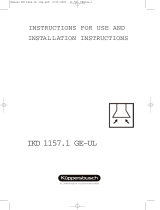14
ENG
Dear client:
Congratulations on your choice. We are sure
that this modern, functional and practical
appliance, made with top quality materials,
will fully satisfy your needs.
Please read every section of this
INSTRUCTIONS MANUAL before using your
kitchen hood for the first time, to ensure
maximum performance from the appliance
and to avoid breakdowns, which may be
caused by incorrect use, as well as to allow
any minor problems to be solved.
Store this manual, as it will provide useful
information about your kitchen hood at all
times and will also help other people to use it.
• Please be aware of current local
regulations with reference to domestic
electrical fittings and gas eduction.
• Verify that the tension and frequency of the
network match those indicated on the label
located inside the kitchen hood.
• The appliance must be connected to the
network using a break switch with a
universal cut off and minimum contact
separation of 3 mm.
• Once the kitchen hood has been installed,
ensure that the mains cable to the network
is not in contact with any live metal edges.
• Avoid connecting the appliance to
conductors used as exits for fumes
produced by a non-electric energy source,
e.g.: boilers, chimneys, etc.
• If the extractor fan is going to be used
simultaneously with equipment powered by
a non-electric energy source, e.g.: gas
cookers, then the room must have
sufficient ventilation.
• Excessive fat accumulation in the kitchen
hood and metal filters is a fire risk and may
also cause dripping, therefore the inside of
the kitchen hood and the metal filters must
be cleaned at least once a month.
• The lower part of the kitchen hood must be
fitted at least 50 cm. over electric hobs and
65 cm. over gas or mixed hobs.
• Never leave gas hobs lit if not covered by a
container. The fat accumulated in the filters
may drip or catch fire when the
temperature increases.
• Avoid cooking under the kitchen hood if the
metal filters are not fitted, e.g.: while they
are being cleaned in the dishwasher.
• You must not produce flames under the
kitchen hood.
• Disconnect the appliance before any
interior manipulation. E.g. during cleaning
or maintenance.
• We recommend the use of gloves and to
be extremely careful when cleaning the
kitchen hood's interior.
• Your kitchen hood is designed for domestic
use and only for extraction and purification
of fumes produced during food
preparation. It will be your responsibility if it
is used for other purposes, which may be
dangerous. The manufacturer cannot
accept responsibility for damage caused
by improper use of the appliance.
• For repairs please contact the nearest
TEKA Technical Assistance Service, and
always use genuine spare parts. Repairs
or modifications carried out by unqualified
personnel can cause malfunctions or may
damage the appliance, putting your safety
in danger.
Safety Instructions








